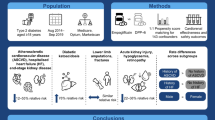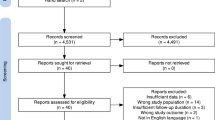Abstract
Background
Although the efficacy of ezetimibe/simvastatin and atorvastatin on traditional lipid parameters has been studied extensively, the apolipoprotein B/apolipoprotein A1 (ApoB/ApoA1) ratio, which has a better predictive value for cardiovascular events, has not previously been used as a primary endpoint in these two treatment groups.
Objective
Our objective was to compare the efficacy and safety of ezetimibe/simvastatin 10/20 mg versus atorvastatin 20 mg once daily in Korean patients with type 2 diabetes mellitus.
Study Design
This study was an open-label, randomized, controlled study. Type 2 diabetes patients with high levels of low-density lipoprotein (LDL) cholesterol (>100 mg/dL) were randomized to receive ezetimibe/simvastatin or atorvastatin.
Main Outcome Measure
The primary endpoint was the difference in the percent change of ApoB/ApoA1 at 12 weeks, and secondary endpoints were changes in lipid profiles, glycosylated hemoglobin (HbA1c), homeostatic model assessment (HOMA) index, and C-reactive protein.
Results
In total, 132 patients (66 for each group) were enrolled and randomized. After 12 weeks of treatment, the ApoB/ApoA1 ratio was significantly reduced in both groups; however, the difference of changes between the two groups was not statistically significant (ezetimibe/simvastatin −38.6 ± 18.0 % vs. atorvastatin −34.4 ± 15.5 %; p = 0.059). There were no significant differences in changes to total cholesterol, LDL cholesterol, high-density lipoprotein cholesterol, triglycerides, ApoB, and ApoB48 between the two groups. However, the increments of ApoA1 were significantly greater in the ezetimibe/simvastatin group than in the atorvastatin group (2.8 ± 10.0 vs. −1.8 ± 9.8 %; p = 0.002). In the per-protocol analysis, improvement in ApoB/ApoA1 was significantly greater in the ezetimibe/simvastatin group (−42.8 ± 11.8 vs. −36.7 ± 13.2 %; p = 0.019). The changes in HbA1c, HOMA index, and C-reactive protein were comparable between the two groups. The adverse reaction rate was similar between the two groups (24.2 vs. 34.9 %; p = 0.180).
Conclusion
Ezetimibe/simvastatin 10/20 mg is comparable to atorvastatin 20 mg for the management of dyslipidemia, and may have more favorable effects on apolipoprotein profiles than atorvastatin 20 mg in Korean patients with type 2 diabetes mellitus.


Similar content being viewed by others
References
Beckman JA, Creager MA, Libby P. Diabetes and atherosclerosis: epidemiology, pathophysiology, and management. JAMA. 2002;287(19):2570–81.
Brunzell JD, Davidson M, Furberg CD, et al. Lipoprotein management in patients with cardiometabolic risk: consensus conference report from the American Diabetes Association and the American College of Cardiology Foundation. J Am Coll Cardiol. 2008;51(15):1512–24.
Walldius G, Jungner I, Holme I, et al. High apolipoprotein B, low apolipoprotein A-I, and improvement in the prediction of fatal myocardial infarction (AMORIS study): a prospective study. Lancet. 2001;358(9298):2026–33.
Yusuf S, Hawken S, Ounpuu S, et al. Effect of potentially modifiable risk factors associated with myocardial infarction in 52 countries (the INTERHEART study): case–control study. Lancet. 2004;364(9438):937–52.
Talmud PJ, Hawe E, Miller GJ, et al. Nonfasting apolipoprotein B and triglyceride levels as a useful predictor of coronary heart disease risk in middle-aged UK men. Arterioscler Thromb Vasc Biol. 2002;22(11):1918–23.
Parish S, Peto R, Palmer A, et al. The joint effects of apolipoprotein B, apolipoprotein A1, LDL cholesterol, and HDL cholesterol on risk: 3510 cases of acute myocardial infarction and 9805 controls. Eur Heart J. 2009;30(17):2137–46.
Sierra-Johnson J, Fisher RM, Romero-Corral A, Somers VK, Lopez-Jimenez F, Ohrvik J, et al. Concentration of apolipoprotein B is comparable with the apolipoprotein B/apolipoprotein A-I ratio and better than routine clinical lipid measurements in predicting coronary heart disease mortality: findings from a multi-ethnic US population. Eur Heart J. 2009;30(6):710–7.
van der Steeg WA, Boekholdt SM, Stein EA, et al. Role of the apolipoprotein B–apolipoprotein A-I ratio in cardiovascular risk assessment: a case–control analysis in EPIC-Norfolk. Ann Intern Med. 2007;146(9):640–8.
Ballantyne CM, Abate N, Yuan Z, et al. Dose-comparison study of the combination of ezetimibe and simvastatin (Vytorin) versus atorvastatin in patients with hypercholesterolemia: the Vytorin Versus Atorvastatin (VYVA) study. Am Heart J. 2005;149(3):464–73.
Goldberg RB, Guyton JR, Mazzone T, et al. Ezetimibe/simvastatin vs atorvastatin in patients with type 2 diabetes mellitus and hypercholesterolemia: the VYTAL study. Mayo Clin Proc. 2006;81(12):1579–88.
Guyton JR, Goldberg RB, Mazzone T, et al. Lipoprotein and apolipoprotein ratios in the VYTAL trial of ezetimibe/simvastatin compared with atorvastatin in type 2 diabetes. J Clin Lipidol. 2008;2(1):19–24.
Ballantyne CM, Blazing MA, King TR, et al. Efficacy and safety of ezetimibe co-administered with simvastatin compared with atorvastatin in adults with hypercholesterolemia. Am J Cardiol. 2004;93(12):1487–94.
Uemura Y, Watarai M, Ishii H, et al. Atorvastatin 10 mg plus ezetimibe 10 mg compared with atorvastatin 20 mg: impact on the lipid profile in Japanese patients with abnormal glucose tolerance and coronary artery disease. J Cardiol. 2012;59(1):50–6.
Tremblay AJ, Lamarche B, Hogue JC, et al. Effects of ezetimibe and simvastatin on apolipoprotein B metabolism in males with mixed hyperlipidemia. J Lipid Res. 2009;50(7):1463–71.
Crouse JR 3rd, Frohlich J, Ose L, et al. Effects of high doses of simvastatin and atorvastatin on high-density lipoprotein cholesterol and apolipoprotein A-I. Am J Cardiol. 1999;83(10):1476–7.
Milionis HJ, Rizos E, Kostapanos M, et al. Treating to target patients with primary hyperlipidaemia: comparison of the effects of ATOrvastatin and ROSuvastatin (the ATOROS study). Curr Med Res Opin. 2006;22(6):1123–31.
US National Center for Health Statistics. Health, United States, 2010: with special feature on death and dying. Hyattsville: National Center for Health Statistics; 2011.
Korean Ministry of Health and Welfare. Korea Health Statistics 2009: Korea National Health and Nutrition Examination Survey (KNHANES IV-3). 2011.
Ravid Z, Bendayan M, Delvin E, et al. Modulation of intestinal cholesterol absorption by high glucose levels: impact on cholesterol transporters, regulatory enzymes, and transcription factors. Am J Physiol Gastrointest Liver Physiol. 2008;295(5):G873–85.
Gylling H, Miettinen TA. Cholesterol absorption, synthesis, and LDL metabolism in NIDDM. Diabetes Care. 1997;20(1):90–5.
Lupattelli G, De Vuono S, Mannarino E. Patterns of cholesterol metabolism: pathophysiological and therapeutic implications for dyslipidemias and the metabolic syndrome. Nutr Metab Cardiovasc Dis. 2011;21(9):620–7.
Okada K, Yagyu H, Kotani K, et al. Lipid-lowering effects of ezetimibe for hypercholesterolemic patients with and without type 2 diabetes mellitus. Endocr J. 2010;57(10):903–8.
Goldberg RB, Guyton JR, Mazzone T, et al. Relationships between metabolic syndrome and other baseline factors and the efficacy of ezetimibe/simvastatin and atorvastatin in patients with type 2 diabetes and hypercholesterolemia. Diabetes Care. 2010;33(5):1021–4.
Huptas S, Geiss HC, Otto C, et al. Effect of atorvastatin (10 mg/day) on glucose metabolism in patients with the metabolic syndrome. Am J Cardiol. 2006;98(1):66–9.
Tanaka A, Yamada N, Saito Y, et al. A double-blind trial on the effects of atorvastatin on glycemic control in Japanese diabetic patients with hypercholesterolemia. Clin Chim Acta. 2001;312(1–2):41–7.
Takano T, Yamakawa T, Takahashi M, et al. Influences of statins on glucose tolerance in patients with type 2 diabetes mellitus. J Atheroscler Thromb. 2006;13(2):95–100.
Her AY, Kim JY, Kang SM, et al. Effects of atorvastatin 20 mg, rosuvastatin 10 mg, and atorvastatin/ezetimibe 5 mg/5 mg on lipoproteins and glucose metabolism. J Cardiovasc Pharmacol Ther. 2010;15(2):167–74.
Moutzouri E, Liberopoulos E, Mikhailidis DP, et al. Comparison of the effects of simvastatin vs. rosuvastatin vs. simvastatin/ezetimibe on parameters of insulin resistance. Int J Clin Pract. 2011;65(11):1141–8.
Pearson T, Ballantyne C, Sisk C, et al. Comparison of effects of ezetimibe/simvastatin versus simvastatin versus atorvastatin in reducing C-reactive protein and low-density lipoprotein cholesterol levels. Am J Cardiol. 2007;99(12):1706–13.
Tamaki N, Ueno H, Morinaga Y, et al. Ezetimibe ameliorates atherosclerotic and inflammatory markers, atherogenic lipid profiles, insulin sensitivity, and liver dysfunction in Japanese patients with hypercholesterolemia. J Atheroscler Thromb. 2012;19(6):532–8.
Naples M, Baker C, Lino M, et al. Ezetimibe ameliorates intestinal chylomicron overproduction and improves glucose tolerance in a diet-induced hamster model of insulin resistance. Am J Physiol Gastrointest Liver Physiol. 2012;302(9):G1043–52.
Deushi M, Nomura M, Kawakami A, et al. Ezetimibe improves liver steatosis and insulin resistance in obese rat model of metabolic syndrome. FEBS Lett. 2007;581(29):5664–70.
Muraoka T, Aoki K, Iwasaki T, et al. Ezetimibe decreases SREBP-1c expression in liver and reverses hepatic insulin resistance in mice fed a high-fat diet. Metabolism. 2011;60(5):617–28.
Dagli N, Yavuzkir M, Karaca I. The effects of high dose pravastatin and low dose pravastatin and ezetimibe combination therapy on lipid, glucose metabolism and inflammation. Inflammation. 2007;30(6):230–5.
Araujo DB, Bertolami MC, Ferreira WP, et al. Pleiotropic effects with equivalent low-density lipoprotein cholesterol reduction: comparative study between simvastatin and simvastatin/ezetimibe coadministration. J Cardiovasc Pharmacol. 2010;55(1):1–5.
Robinson JG, Ballantyne CM, Hsueh W, et al. Achievement of specified low-density lipoprotein cholesterol, non-high-density lipoprotein cholesterol apolipoprotein B, and high-sensitivity C-reactive protein levels with ezetimibe/simvastatin or atorvastatin in metabolic syndrome patients with and without atherosclerotic vascular disease (from the VYMET study). J Clin Lipidol. 2011;5(6):474–82.
Conard S, Bays H, Leiter LA, et al. Ezetimibe added to atorvastatin compared with doubling the atorvastatin dose in patients at high risk for coronary heart disease with diabetes mellitus, metabolic syndrome or neither. Diabetes Obes Metab. 2010;12(3):210–8.
Funding
This study was supported by a grant from MSD, Inc., South Korea. Funding had no influence on study design, collection, analysis and interpretation of data or writing and submission of manuscript.
Conflicts of interest
None of the authors have any potential conflicts of interest.
Author information
Authors and Affiliations
Corresponding author
Additional information
ClinicalTrials.Gov Registration Number: NCT01185236.
Rights and permissions
About this article
Cite this article
Lee, JH., Kang, HJ., Kim, HS. et al. Effects of Ezetimibe/Simvastatin 10/20 mg vs. Atorvastatin 20 mg on Apolipoprotein B/Apolipoprotein A1 in Korean Patients with Type 2 Diabetes Mellitus: Results of a Randomized Controlled Trial. Am J Cardiovasc Drugs 13, 343–351 (2013). https://doi.org/10.1007/s40256-013-0031-6
Published:
Issue Date:
DOI: https://doi.org/10.1007/s40256-013-0031-6




